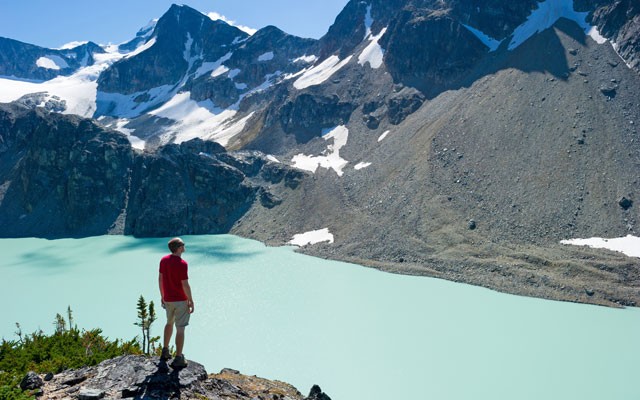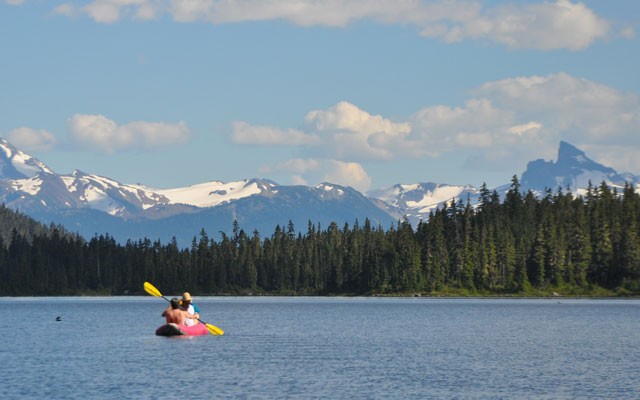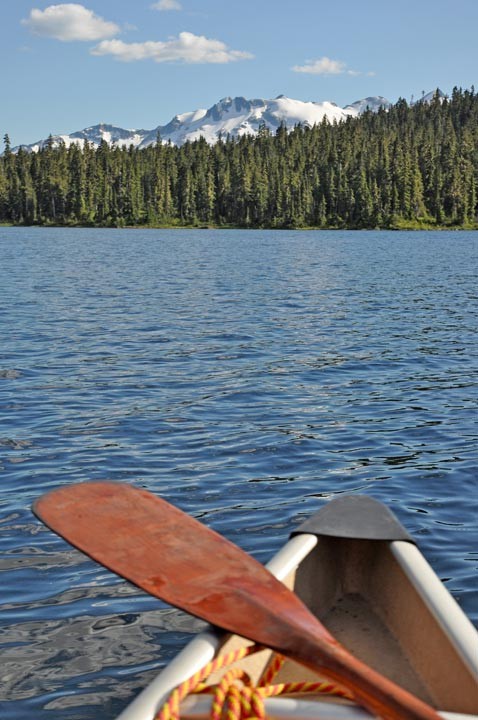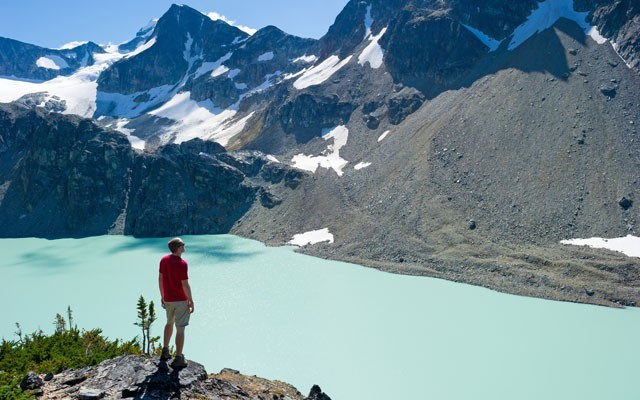Summer can be a fickle season in the Coast Mountains. Exhibit A: The recent mid-July snowfall in the alpine regions around Whistler. Better hurry. Before you know it ice crystals will be forming soon on subalpine lakes and trails, glassing turquoise-hued surfaces and sprouting from newly frosted ground.
Now is the time to pay a visit shod in hiking boots or with a paddle in hand, to be replaced soon enough by ski poles or snowshoes. And what a magical time August is. Nature's treasure chest waits in a landscape aglow with Indian paintbrush in five shades from coral to crimson and purple sky pilots. Come along as Pique offers the keys to two such recently visited vaults.
First up: Callaghan Lake, set in the provincial park of the same name. Poised at tree line just south of the resort, the initial approach is easily accomplished. A blacktopped road winds uphill from the Sea to Sky Highway and delivers travellers to the entrance of the Whistler Olympic/ Paralympic Park, or WOP, one of the lasting legacies of the 2010 Winter Games. Pause here for a quick look at Alexander Falls where waters from Madeley Creek tumble below a wooden bridge and course downhill through a thickly-wooded valley to merge with the Cheakamus River. At this small, easily accessible recreation site, Alexander Falls forms in three drops. Experience the special magic of this spot on a bench that honours a couple who vowed eternal love here years earlier. Hold that kiss.
The road above the WOP transitions abruptly from asphalt to bedrock for the eight-kilometre climb to lakeside. With luck, BC Parks may have graded the route. Snowfall accumulations in the upper Callaghan Valley are typically prodigious and leave the approach road to the lake unsuitable for four-wheeled vehicles in all but summer and early-autumn months. Depending on the size and frequency of potholes, allow as much as a half-hour to reach the lake's shoreline. A rough launch site with several channels cleared of jagged-edged granite teeth invites kayaks, canoes and SUPs to float onto the clear depths of the two-kilometre-long lake. The voice of a waterfall at the lake's far end, augmented by wind in the branches of the old-growth forest, carries in the air and blends into a common chord with an airy note rising closer at hand where Callaghan Creek makes its rapid outflow. From this vantage point, views of surrounding Coast Mountains trump all else. Pairs of loons glide along, momentarily diving then bobbing up to keep a wary eye on your progress. From out on the lake, a parade of peaks suddenly appears above the timberline, foremost Garibaldi Provincial Park's signature peak, Black Tusk. Allow a half-hour to reach the lake's far end; having endured the approach road there's no need to rush. Drift in the shallows to catch the light show as the shadows of paddlers and the ripples set off by the dip of paddle blades dance across the emerald-coloured bottom, an aquatic display second-to-none.

PHOTO BY MIKE CRANE/TOURISM WHISTLER - Wedgemount Lake Hike, Wedge Mountain.
Not everyone owns a watercraft but almost all of us are blessed with legs. What kind of shape are yours in? If you've spent time this summer putting one foot in front of the other on a mountain trail or two, reward yourself with a climb to Wedgemount Lake, whose trailhead lies just north of the Emerald Estates neighbourhood via a short, well-maintained dirt road off Highway 99. One caveat: at seven kilometres in length, this trail may not seem that great a distance. Don't be fooled. The average three-hour ascent to the glacier-fed lake will give a true measure of your fitness's worth. The relentless descent may hobble even the most avid Singing Pass habitué. Do yourself a favour: if you doubt you or your companion's abilities, treat yourself to the much gentler trail to equally-enchanting Cheakamus Lake, a three-kilometre ramble whose well-marked trailhead lies near Function Junction.
A profusion of colourful fungi sprout beside the Wedgemount Lake Trail. The lake feeds a creek of the same name whose course parallels the trail for much of the way. Its commotion spurs hikers upward toward the source of all that tumbling whitewater glimpsed occasionally through the trunks of the old-growth fir forest whose stocky size diminishes in accordance with the gain in altitude. The cruelest part of this test lies near the top; just when you think the trail can't get any steeper, it does. If at this point you entertain second thoughts, listen to your body. If in doubt, don't. There's no shame in turning back. The lake won't disappear any time soon, though the glacier that feeds it has shrunk noticeably since Pique first reported on this route three decades ago. Try again another time.

PHOTO BY LOUISE CHRISTIE - View of the iconic Black Tusk and Whistler Mountain from Callaghan Lake.
The sentiments of those who do surmount the final rocky pitch are recorded in a log book kept inside a modest cabin poised above the lake. Entry after entry raves about the beauty of the setting amid Garibaldi's tallest peaks played off against the challenge of the climb. One overachiever boasts of having reached this point in less than two hours. Whatever. Not just the fittest reap the accolades; all who make it share equally in the glorious rewards.
Access: For details on both Callaghan Lake and Garibaldi Provincial Parks, see www.env.gov.bc.ca/bcparks.
Pique contributor Jack Christie is the author of The Whistler Book (Greystone). For more information, visit www.jackchristie.com.





